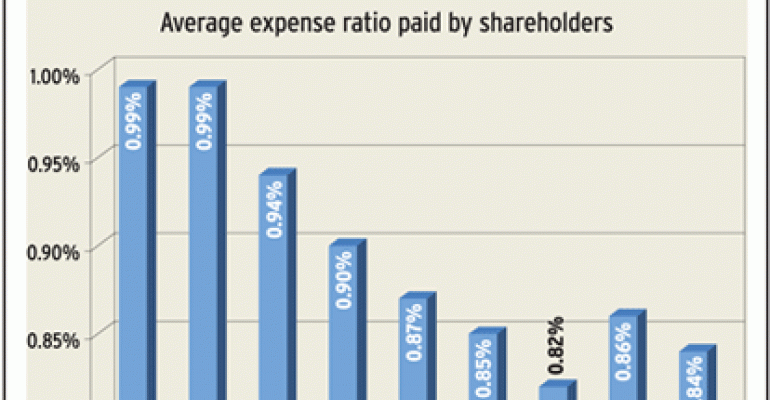During his long career, Vanguard Group founder John Bogle has often argued that most actively managed funds trail their benchmarks. In his book Common Sense on Mutual Funds, Bogle notes that 79 percent of active funds lagged the S&P 500 during the 20 years ending in 1998. Recent studies by Bogle and other researchers have reached similar conclusions. Seeing the data, academic researchers have decided that fund investors as a group make foolish choices. Instead of buying cheap index funds, investors persist in buying expensive active funds that fail again and again to top the benchmarks.
But studies by Morningstar and the Investment Company Institute (ICI) suggest that fund shareholders may not be so dumb after all. According to the latest data, investors gravitate to low-cost funds with strong track records. “People make reasonably intelligent choices when they pick active funds,” says John Rekenthaler, Morningstar’s vice president of research.

Rekenthaler says that studies by Bogle and other researchers do not provide a clear picture of how typical investors actually fare. The problem is that many active funds are tiny and serve few investors. The funds are small—and likely to stay that way—because they have high fees and poor returns. At the other end of the size spectrum are big funds that attract investors by maintaining low fees and competitive returns. While the small funds only serve a limited number of investors, the academic studies give equal weight to all funds—regardless of their size. The academic approach produces a distorted picture, says Rekenthaler. “It doesn’t matter what percentage of funds trail the index,” says Rekenthaler. “What matters most is how the big funds do. That’s where most of the money is.”
To appreciate Rekenthaler’s argument, consider the 349 large blend funds with 10-year records that are tracked by Morningstar. During the decade that ended in October 2011, 56 percent of the funds trailed the S&P 500. By that measure, the active funds appear to have failed their investors. But many of the worst funds harmed only a few shareholders. Among the losers was Saratoga Large Capitalization Value (SLCVX), which charges an annual expense ratio of 2.6 percent and lagged the S&P 500 by 4.9 percentage points annually. While the record was abysmal, the damage was small because the fund only has $17 million in assets. At the other of the spectrum is Hartford Capital Appreciation (HIACX), which has $8.6 billion in assets. Hartford topped the S&P 500 by 3.5 percentage points annually and has an expense ratio of 0.67 percent. Tiny funds are not a rarity. Of the large blend funds, 25 percent have less than $70 million in assets. Together those small funds hold total assets that are less than those of each of the 25 biggest funds.
In order to get a realistic picture of fund results, Rekenthaler calculated asset-weighted returns—the average return of each invested dollar. Under his system, large funds carry more weight than small ones. He also calculated average returns, which give equal weight to each fund. Altogether Morningstar looked at how 16 stock-fund categories performed during the ten years ending in 2010. In each category, the asset-weighted return was higher than the result that was achieved when each fund carried the same weight.
Consider the small-growth category. On an equal-weighted basis, active funds returned 2.89 percent annually and trailed the benchmark, which returned 3.78 percent. But the asset-weighted figure for small-growth funds exceeded the benchmark by 0.20 percentage points. Categories where active funds won by wide margins included world stock, small blend, and health. Active funds trailed in large blend and mid growth. The asset-weighted result topped the benchmark in half the categories. In most of the eight categories where the active funds lagged, they trailed by small margins. “There is still an argument for indexing, but the argument is not as strong when you look at this from an asset-weighted basis,” says Rekenthaler.
Part of the reason for the strong asset-weighted returns may be that investors are increasingly moving to low-cost funds. The shift was documented in a study by the ICI that looks at asset-weighted expenses as well as equal-weighted figures. In 1996, the simple average expense ratio was 1.55 percent, and the figure declined to 1.45 percent by 2010. During the same time, the asset-weighted figure dropped from 1.03 percent to 0.84 percent. According to the ICI data, investors have been gravitating to large funds with low fees.
The ICI says that the movement into low-cost funds has been accelerating. During the period from 2000 to 2010, funds with expense ratios in the cheapest quartile attracted 82 percent of all net new cash inflows. The pattern is particularly pronounced for index funds, where investors have learned to shop for bargains. According to the ICI, index funds in the cheapest quartile attracted 86 percent of assets. Of S&P 500 funds, 63 percent of assets were in funds that have expense ratios of 0.10 percent or less. Only 15 percent of assets were in funds with expense ratios of 0.20 percent or more.
Does the data prove that funds investors have become geniuses? Hardly. The numbers indicate that when they are choosing from among the many funds on the market, investors tend to pick the right ones. But investors display remarkably bad timing for their purchases and sales. Studies by research firm Dalbar have shown that over the past two decades, fund investors have typically bought at market peaks and sold at troughs.
Still, the asset-weighted studies suggest that the people who pick funds are not completely inept. This should not come as a surprise. In the past decade, do-it-yourself investors have been fading from the scene. Instead most fund investments have come from retirement plans or clients who rely on advisors. Advisors and plan sponsors may disagree on strategy, but virtually all of them understand that low-cost funds tend to outperform expensive ones. By increasingly favoring low-cost funds, advisors and other investors have improved their chances of topping the benchmarks.






